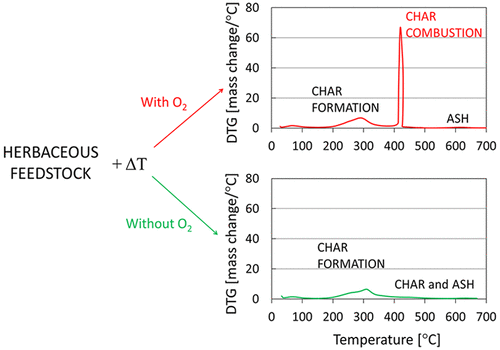当前位置:
X-MOL 学术
›
J. Chem. Educ.
›
论文详情
Our official English website, www.x-mol.net, welcomes your
feedback! (Note: you will need to create a separate account there.)
Application of Thermal Analysis in Determining Properties of Herbaceous Materials
Journal of Chemical Education ( IF 2.5 ) Pub Date : 2018-06-01 00:00:00 , DOI: 10.1021/acs.jchemed.7b00180 Ewa Iwanek (née Wilczkowska) 1 , Marek Gliński 2
Journal of Chemical Education ( IF 2.5 ) Pub Date : 2018-06-01 00:00:00 , DOI: 10.1021/acs.jchemed.7b00180 Ewa Iwanek (née Wilczkowska) 1 , Marek Gliński 2
Affiliation

|
In this laboratory experiment, students performed thermogravimetric analysis (TGA) coupled with mass spectrometry (MS) of herbaceous materials (TGA-MS) and learned to analyze mass-loss curves, as well as identify common fragmentation ions. The experiment is the first one to present the application of TGA in a currently relevant topic: biomass conversion. A preweighed dry sample of herbaceous origin treated to 700 °C with a steady temperature increase rate exhibited the following mass-loss steps: desorption of adsorbed species (e.g., H2O and CO2) followed by char formation via emission of volatile organic compounds and small inorganic molecules. Next, when the process is carried out in the presence of oxygen, the formed char combusted leaving only the ash in the thermobalance crucible. The proportions of these mass losses are significant in the study of biomass for any potential application, such as in the production of energy in plants which already currently utilizes a mixture of coal and plant-based materials. A comparison of two TGA curves obtained from two portions of the same sample heated in an inert and oxygen-containing atmosphere enabled students to determine if and how the char-formation step is influenced by the presence of oxygen. Students also acquired mass spectrometry data from the gaseous stream that was emitted from the sample during the recorded mass-loss steps. Therefore, students were able to gain a basic understanding of what can happen to biomass upon heating, i.e., formation of H2O (m/z = 18) and CO2 (m/z = 44), and the release of simple organic molecules from complex organic matter, which is manifested in the MS spectrum by the presence of positively charged fragments (m/z = 29, 43, 77, 91, etc.).
中文翻译:

热分析在确定草本材料性能中的应用
在此实验室实验中,学生进行了热重分析(TGA)和草本材料的质谱(MS)(TGA-MS)结合,并学会了分析质量损失曲线,以及识别常见的碎片离子。该实验是第一个介绍TGA在当前相关主题:生物质转化中的应用的实验。预先称重的草本植物干燥样品以稳定的升温速度处理至700°C,表现出以下质量损失步骤:吸附物质(例如H 2 O和CO 2的解吸)),然后通过散发挥发性有机化合物和无机小分子而形成炭。接下来,当该过程在氧气存在下进行时,形成的炭燃烧,仅在燃烧天平坩埚中留下灰烬。这些质量损失的比例在任何潜在应用的生物质研究中都是非常重要的,例如在目前已经利用煤和植物基材料的混合物的工厂生产能源中。从在惰性和含氧气氛中加热的同一样品的两部分获得的两条TGA曲线的比较,使学生能够确定是否以及如何通过氧气的存在来影响成炭步骤。学生还从记录的质量损失步骤中从样品中释放出的气流中获取了质谱数据。2 O(m / z = 18)和CO 2(m / z = 44),并从复杂的有机物中释放出简单的有机分子,这在MS光谱中通过带正电荷的碎片(m / z = 29、43、77、91等)。
更新日期:2018-06-01
中文翻译:

热分析在确定草本材料性能中的应用
在此实验室实验中,学生进行了热重分析(TGA)和草本材料的质谱(MS)(TGA-MS)结合,并学会了分析质量损失曲线,以及识别常见的碎片离子。该实验是第一个介绍TGA在当前相关主题:生物质转化中的应用的实验。预先称重的草本植物干燥样品以稳定的升温速度处理至700°C,表现出以下质量损失步骤:吸附物质(例如H 2 O和CO 2的解吸)),然后通过散发挥发性有机化合物和无机小分子而形成炭。接下来,当该过程在氧气存在下进行时,形成的炭燃烧,仅在燃烧天平坩埚中留下灰烬。这些质量损失的比例在任何潜在应用的生物质研究中都是非常重要的,例如在目前已经利用煤和植物基材料的混合物的工厂生产能源中。从在惰性和含氧气氛中加热的同一样品的两部分获得的两条TGA曲线的比较,使学生能够确定是否以及如何通过氧气的存在来影响成炭步骤。学生还从记录的质量损失步骤中从样品中释放出的气流中获取了质谱数据。2 O(m / z = 18)和CO 2(m / z = 44),并从复杂的有机物中释放出简单的有机分子,这在MS光谱中通过带正电荷的碎片(m / z = 29、43、77、91等)。











































 京公网安备 11010802027423号
京公网安备 11010802027423号